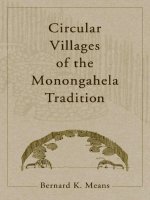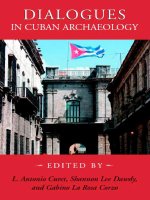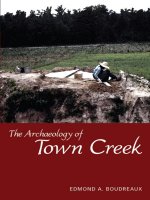university alabama press archaeology of the lower muskogee creek indians 1715-1836 jan 2007
Bạn đang xem bản rút gọn của tài liệu. Xem và tải ngay bản đầy đủ của tài liệu tại đây (2.18 MB, 320 trang )
Archaeology of the Lower Muskogee
Creek Indians, 1715–1836
A Dan Josselyn Memorial Publication
Archaeology of the Lower Muskogee
Creek Indians, 1715–1836
H. THOMAS FOSTER II
With Contributions by Mary Theresa Bonhage-Freund
and Lisa O’Steen
THE UNIVERSITY OF ALABAMA PRESS
Tuscaloosa
Copyright © 2007
The University of Alabama Press
Tuscaloosa, Alabama 35487-0380
All rights reserved
Manufactured in the United States of America
Typeface: Minion
∞
The paper on which this book is printed meets the minimum requirements of American
National Standard for Information Sciences—Permanence of Paper for Printed Library
Materials, ANSI Z39.48-1984.
Library of Congress Cataloging-in-Publication Data
Foster, Thomas, 1970–
Archaeology of the Lower Muskogee Creek Indians, 1715–1836 / H. Thomas Foster II ; with
contributions by Mary Theresa Bonhage-Freund and Lisa O’Steen.
p. cm.
Includes bibliographical references and index.
ISBN-13: 978-0-8173-1239-8 (cloth : alk. paper)
ISBN-10: 0-8173-1239-0
ISBN-13: 978-0-8173-5365-0 (pbk. : alk. paper)
ISBN-10: 0-8173-5365-8
1. Creek Indians—Chattahoochee River Valley—Antiquities. 2. Creek Indians—Material
culture—Chattahoochee River Valley. 3. Excavations (Archaeology)—Chattahoochee River
Valley. 4. Chattahoochee River Valley—Antiquities. I. Bonhage-Freund, Mary Theresa.
II. O’Steen, Lisa, 1956– III. Title.
E99.C9F67 2007
758.004′97385—dc22
2006014322
To the Maskókalkî
Excavating or collecting artifacts from federal property without a
permit is a criminal offense punishable by ¤nes, imprisonment, and
con¤scation of property.
Contents
List of Figures ix
List of Tables xiii
Preface xv
Acknowledgments xxi
Notes on Orthography and Pronunciation xxiii
1. Ethnohistoric Context 1
2. Environmental Context 26
Thomas Foster and Mary Theresa Bonhage-Freund
3. History of Archaeological Investigations 37
4. Pottery 72
5. Architecture 102
6. Botanical Remains 136
Mary Theresa Bonhage-Freund
7. Animal Remains 194
Lisa O’Steen
8. Conclusion 256
Bibliography 267
Index 289
1.1. Region of the Muskogee Creek Indians during the eighteenth to early
nineteenth centuries 3
1.2. Creek town layout, adapted from Ephraim G. Squier’s engraving of
“Creek Towns and Dwellings” 23
2.1. Map of the region of the Lower Creek Indians (1715–1836) 35
2.2. Georgia rainfall between 1700 and 1836 as estimated from
dendrochronology 36
3.1. Region of the Chattahoochee River showing the Walter F. George
Reservoir, the Fort Benning Military Reservation, and the Oliver
Basin archaeological surveys 38
3.2. Location of Cheauhoochee, Apalachicola, and the Spanish Fort
(1689–1691) on the Chattahoochee River during the eighteenth to
early nineteenth centuries 47
3.3. Location of Auputaue on the Upatoi Creek during the eighteenth to
early nineteenth centuries 51
3.4. Location of Yuchi, Oosoochee, Captain Ellick’s town, Cheahau,
Ocmulgee, and Hitchitee on the Chattahoochee River during the
eighteenth to early nineteenth centuries 53
3.5. Location of Cussetuh, Cussetuh Old Town, Cowetuh, and Cowetuh
Talluahassee on the Chattahoochee River during the eighteenth to
early nineteenth centuries 55
3.6. Location of Sauwoogelo and Tamathli on the Chattahoochee River
during the eighteenth to early nineteenth centuries 61
Figures
3.7. Location of Eufaula on the Chattahoochee River during the
eighteenth to early nineteenth centuries 62
3.8. Portion of 1827 Lee County (currently Stewart County), Georgia,
District 22, plat map showing the location of Hitchiti and Osucha 64
3.9. Location of Oconee on the Chattahoochee River during the
eighteenth to early nineteenth centuries 66
4.1. All archaeological sites situated along the Chattahoochee and Flint
River Valleys that contain Lawson Field (circa 1715–1836)
components 80
4.2. Relative frequencies of Lawson Field ceramic types by total sherd
count at all known Lower Creek sites in the Chattahoochee and Flint
River valleys 87
4.3. Two Chattahoochee Roughened var. Chattahoochee vessels from
Cussetuh 88
4.4. Two Mission Red Filmed vessels from Cussetuh 89
4.5. Five Lamar Incised var. Ocmulgee Fields vessels from Cussetuh 90
4.6. Relative frequencies of ceramic types by total sherd count in single
Lawson Field component features at all known Lower Creek sites in
the Chattahoochee and Flint River Valleys 91
4.7. Relative frequencies of ceramic types segregated by linguistic
af¤liation of the town in which the ceramics were found 93
4.8. Principal components analysis (PCA) of relative frequencies of total
sherd counts in single Lawson Field component features at all known
Lower Creek sites in the Chattahoochee and Flint River valleys 94
4.9. Vessel forms from a sample of Lower Creek Indian vessels from
excavations at Cussetuh, Buzzard Roost, and the Victory Drive
sites 96
5.1. The Creek Indian Square Ground buildings, from William Bartram’s
drawing of “The Principal, or Council House” by Edwin Davis 105
5.2. Plan of the Cussetuh Square Ground according to Benjamin
Hawkins 106
5.3. “Indian huts west of the Chattahoochee river, 7, April 1828,” by Basil
Hall 111
5.4. Circular structure at 1BR35 113
x / Figures
5.5. Vertical post design architecture excavated at 9TR41 (Buzzard Roost,
circa 1770–1788) 115
5.6. Block excavation of 9TR54, “Buzzard Roost,” showing rectangular
features 116
5.7. Feature concentration of 9TR54, “Buzzard Roost,” showing
rectangular feature and possible aboveground house 117
5.8. Ochille Creek site excavation showing features and archaeological
distribution of a single rectangular household compound 118
5.9. Ochille Creek site excavation showing posthole features from a
structure and clay extraction pits in close vicinity of a single
rectangular household compound 119
5.10. Rectangular “house” structure identi¤ed by Gordon Willey
(1938) 121
5.11. Structure areas A and B at the 2001 excavation of Cussetuh (9CE1) at
Fort Benning Military Reservation, Georgia 123
5.12. Structure areas C and D at the 2001 excavation of Cussetuh (9CE1) at
Fort Benning Military Reservation, Georgia 124
5.13. Structure area E at the 2001 excavation of Cussetuh (9CE1) at Fort
Benning Military Reservation, Georgia 125
5.14. Structure area F at the 2001 excavation of Cussetuh (9CE1) at Fort
Benning Military Reservation, Georgia 127
5.15. Structure area G at the 2001 excavation of Cussetuh (9CE1) at Fort
Benning Military Reservation, Georgia (Foster 2004e) 128
5.16. Structure area H at the 2005 excavation of Cussetuh (9CE1) at Fort
Benning Military Reservation, Georgia 130
5.17. Structure area I at the 2005 excavation of Cussetuh (9CE1) at Fort
Benning Military Reservation, Georgia 131
5.18. Structure area J at the 2005 excavation of Cussetuh (9CE1) at Fort
Benning Military Reservation, Georgia 132
7.1. Butchered cattle elements from Feature 1, Cowetuh Settlements
(9ME50) 220
7.2. A–H, butchered deer metapodials from Feature 1; I–K breakage
pattern and cut spurs on turkey metatarsals, Feature 2, Cowetuh
Settlements (9ME50) 221
Figures / xi
7.3. Diagram of hacked cuts on deer elements, Feature 2, Cowetuh
Settlements (9ME50) 224
7.4. Diagrams of hacked cuts on deer, cattle, and pig elements, Feature 8,
Ochillee Creek Farmstead (9CE379) 230
xii / Figures
Tables
2.1. Percentage of land cover at Fort Benning, Georgia, over time 33
3.1. Ceramic types in the Lawson Field phase according to current
de¤nitions 44
4.1. Lower Creek Indian archaeological sites included in the ceramics
synthesis 77
4.2. Relative frequency of surface decoration type found in a sample of
vessels from excavations at Cussetuh, Buzzard Roost, and the Victory
Drive sites in Georgia 99
5.1. Creek Indian structures that have been excavated along the
Chattahoochee and Flint Rivers dating between 1715 and 1836 112
6.1. Historically documented plant use by the Creek Indians 140
6.2. Summary of macroplant remains from Historic Creek Indian
sites 150
6.3. Wood charcoal identi¤cations from Cussetuh, Buzzard Roost, Ochillee
Creek, and Yuchi Town 160
6.4. Summary of maize cob shape data from Buzzard Roost (9TR41 and
9TR54) (Bonhage-Freund 1999) 172
6.5. Wood charcoal from Buzzard Roost (9TR41) (Bonhage-Freund
1999) 175
6.6. Wood charcoal from Buzzard Roost (9TR54) (Bonhage-Freund
1999) 177
7.1. Faunal material recovered from feature contexts at Cussetuh
Town 203
7.2. Faunal material recovered by speci¤c feature context at Cussetuh
Town 205
7.3. Faunal assemblage modi¤cations 207
7.4. Skeletal representation of cow and deer elements 209
7.5. Species list: Salenojuh or Buzzard’s Roost Town (9TR54),
features 213
7.6. Species list: Salenojuh or Buzzard’s Roost Town (9TR54), feature
®otation samples 214
7.7. Element distribution: Salenojuh or Buzzard’s Roost Town (9TR41,
9TR54) 216
7.8. Species list: Cowetuh Settlements (9ME50), Feature 2 222
7.9. Element distribution: Cowetuh Settlements (9ME50), Feature 2 223
7.10. Species list: Ochillee Creek Farmstead, Feature 8 228
7.11. Distribution of elements of deer, pig, and cattle at the Ochillee Creek
Farmstead, Feature 8 232
7.12. Taxa identi¤ed on Lower Creek sites, eighteenth to early nineteenth
century: Salenojuh or Buzzard’s Roost Town, Cowetuh Settlements,
Cussetuh Town, and Ochillee Creek Farmstead 235
7.13. Comparison of MNI and biomass percentages for identi¤ed taxa from
Lower Creek sites, eighteenth to early nineteenth centuries 237
7.14. MNI and biomass percentages combined for Lower Creek Sites in
Georgia, 1750–1820 239
7.15. Element distribution: Lower Creek sites (Salenojuh or Buzzard’s Roost
Town, Cowetuh Settlements, Cussetuh Town, and Ochillee Creek
Farmstead), eighteenth to early nineteenth centuries 240
xiv / Tables
The purpose of this book is to investigate the diversity of the people referred
to as the Muskogee (Maskókî) Creek Indians who lived along the Lower Chat-
tahoochee and Flint River watersheds of southeastern North America during
the eighteenth to early nineteenth centuries as revealed through archaeological
remains. This investigation will synthesize all known archaeological research
at Lower Muskogee Creek sites.
The Muskogee Indians were and continue to be a diverse people. During the
Historic Period (circa 1540–1836), they and other Indians of the southeastern
United States had a profound in®uence on the development of that region. Our
knowledge of those cultures is limited to what we can learn from their descen-
dants and from archaeological and historical sources. This book is about what
we can learn from archaeological data.
This is the ¤rst published comprehensive archaeological summary of the
Lower Creek Indians. While its intended audience is archaeologists, I expect
that the readership will be more widespread than just professionals, and I hope
that the synthesis described here is useful for a wider audience, including the
modern descendants of the historic tribes that I discuss. Given the potential
for a larger readership, I will brie®y discuss the limitations of the methods and
perspectives used in this book.
I have worked for many years to collaborate with the descendants of the
people described here and know from their advice that I cannot hope to “sum-
marize” their past or culture (Mihesuah 1998; Wickman 1999:5–6). Since this
book focuses on the realm of information that can be identi¤ed from archaeo-
logical data, I want to point out that the view of the Muskogee Creek Indians
as revealed from those data is limited. Studying archaeological remains pro-
vides a biased view of the lives and cultural heritage of a group of people, and
the results in this book are no exception. This book leaves out signi¤cant por-
tions of culture because it is limited to what we can learn from the preserved
Preface
remains of behaviors. Archaeological data are limited to material remains.
Consequently, archaeological knowledge is narrowly focused. For example, the
review here does not cover the religious beliefs of the Indians or what kinds of
traditional beliefs were held about life events. I don’t want to claim that it is im-
possible for archaeologists to deal with these subjects, but nonemperical sub-
jects have not been traditionally the subject of archaeological inquiry. There-
fore, there is little for me to say in this book, which is a synthesis of existing
work.
Archaeological data, however, have signi¤cant advantages over other types
of data such as interviews, oral histories, and historic documents. Archaeologi-
cal data are systematic and can be indiscriminately represented for large por-
tions of the population. In other words, archaeological data can be relatively
comprehensive and unbiased toward diverse sections of the society. For example,
historic documents are biased, as they are written by individuals and repre-
sent the perspective, interpretation, and agenda of a single individual. Simi-
larly, oral histories are told, remembered, and interpreted by individuals (Saunt
1999:31–34) and vary by clan and town (talwa) (Wickman 1999:61). The Mus-
kogee Creek Indians have a rich tradition of oral histories, but I have not drawn
signi¤cantly upon that source for this book because doing so would incorpo-
rate a new set of biases (Jackson 2003:30–32). Other researchers (Grantham
2002; Jackson 2003; Swanton 1928a, b; Wickman 1999) have addressed oral his-
tories; therefore, my focus is on what can be learned from archaeological data.
Archaeological artifacts such as food remains may be preserved for all mem-
bers of a given household. In this way archaeological data complement oral
histories and historic documents. Archaeological data are unique in that they
provide information about daily life that was not preserved in oral histories.
Other than oral histories, archaeological data are, possibly, the only source of
information that is directly from the people themselves. Archaeological remains
are not necessarily biased by an “other” perspective (Mihesuah 1998; Watkins
2000; Wickman 1999); however, their interpretation may be biased.
This book provides a synthesis of the archaeological perspective and is an
attempt to describe the variation of that perspective over time and space. By
quantifying the variation of the material culture over space and time, archae-
ologists will be able to better identify causes for change among the Indians. It
is only after we understand the geographic and temporal variation that we can
understand the causes of material change and adaptation through time and
can distinguish the differences between individual Creek Indian towns (Piker
2003, 2004:6–8). Consequently, I spend a considerable amount of time describ-
ing the variation in the archaeological assemblages and feature types. I also
identify the archaeological context where the artifacts were found so that the
reader can evaluate the conclusions without referring to unpublished and un-
xvi / Preface
available reports. Sometimes, archaeological interpretations are based on the
remains found in a single feature. Since the perspective of an entire culture
or people cannot be determined with reasonable reliability or validity from a
single feature, it is important to clarify how our conclusions were determined.
I have attempted to list all known sources while drawing on the more system-
atically collected data. It is important that the reader know the entirety of the
sites while understanding that not all collected data are equally useful. I discuss
these limitations so that the reader can evaluate my conclusions.
Archaeologists are beginning to have a relatively comprehensive view of
the variation among the material culture that represents the Lower Muskogee
Creek Indians. Large sections of the habitat where they lived have been sur-
veyed for archaeological remains. Some of the region has been completely sur-
veyed. It is timely, therefore, to take account of that variation in order to better
understand the diversity of the material culture of the Muskogee people and
to better protect the remaining sites.
Much is known, but there is much more to learn about these people. For
example, we certainly don’t know much about the subsistence variation over
large regions or changes in the economy in any detail. We have practically no
idea about the meaning of most of the artifacts that are recovered. We don’t
know much about demography at a reasonable accuracy. We don’t know about
health or reproductive changes during the eighteenth century, although we
think that they were dramatic. This book is a starting point rather than an end.
One of the goals of this book is to synthesize the vast amount of research
on Lower Muskogee Creek Indian sites. There have been decades of cultural
resource management research on those archaeological sites, but little of it has
had peer review or been published. Most of the data sources are in museums,
unpublished manuscripts and cultural resource management reports, and per-
sonal collections.
Archaeological investigations from cultural resource management projects
are often designed with nonanthropological research goals that make the samples
collected relevant to nonanthropological questions and more dif¤cult to com-
bine with anthropological studies. While most cultural resource management
reports summarized here listed culture history research problems as a goal, the
purposes of the studies were for evaluation in the National Register of Historic
Places (NRHP). Consequently, samples collected and budgets and time allo-
cated were solely for NRHP assessment. For example, we may have archaeo-
logical data on only a portion of a site that was within a construction area of
a road. Consequently, our interpretation of that site is biased by the cultural
resource management goals, which were to assess NRHP eligibility of or miti-
gate the cultural resources within a particular distance from the road. While
we are blessed with a great deal of information from cultural resource manage-
Preface / xvii
ment, the reporting of that data is, to say the least, frustrating. Site reports are
dif¤cult to obtain and are rarely in a peer-reviewed published format. If we do
not adequately disseminate and review the results from cultural resource man-
agement projects, the information gained from them is lost. At the same time,
we have to recognize that most of the research on Lower Muskogee Creek In-
dian sites has been on such funded projects. These applied archaeology re-
search projects have their own biases and goals, but the mere volume of data
makes them impossible, if not irresponsible, to ignore. A synthesis of the
Lower Muskogee Creek Indian archaeology is a synthesis of cultural resource
management-funded projects. This book establishes a baseline of knowledge
about the material remains of the Muskogee people partly by publishing data
that have been dif¤cult to obtain because they were in unpublished and rare
reports.
To characterize fully the material remains of the Muskogee, a book, ideally,
should discuss their origins and all aspects of their society. I feel that we do not
know enough about the origins or boundaries (social, economic, temporal, or
geographic) of those people to accomplish that. So another goal of this book
is to isolate and describe some of the boundaries and variation of what we do
know. The temporal and geographic boundaries of this book are limited to the
period after the Muskogee Creek Indians settled on the Chattahoochee River
in the beginning of the eighteenth century until the state and federal govern-
ments in the beginning of the nineteenth century forcibly removed them (circa
1715–1836). That time period also corresponds to an archaeological phase, the
Lawson Field phase (Knight 1994b). I intentionally limited the book to this
phase so that we could characterize the variation within that archaeological
and temporal unit. I am not convinced that we understand quantitatively the
difference between Creek Indian artifacts of the eighteenth century and those
of the seventeenth century, nor do we understand population migration during
that period. I didn’t want to introduce more confounding archaeological vari-
ables by including multiple phases in the synthesis. I also limited the book to
the Lower Creek Indians instead of incorporating all of the Creek Indians be-
cause the survey region of the Lower Creek Indians is better de¤ned than the
Upper Creek region. Many of the Upper Creek archaeological excavations are
either ongoing or not yet completely reported. Last, there is ethnic and political
justi¤cation for the division between the Lower and Upper Creek towns (Jack-
son 2003). This book is about the people, but it is also about how archaeologists
know what they know. It examines the evidence for the archaeological cultural
unit that currently represents the Lower Creek Indians.
Chapters are organized by archaeological data type. Chapter 1 is a survey of
ethnohistoric and ethnographic information about the Muskogee Creek Indi-
xviii / Preface
ans that is speci¤cally relevant to the interpretation of archaeological investi-
gations. There are many books on Creek Indian ethnohistory and ethnography,
some of them recent (Braund 1993; Ethridge 2003; Hahn 2004; Jackson 2003;
Piker 2004; Saunt 1999; Swanton 1922, 1928a, b; Waselkov and Braund 1995;
Wickman 1999; Wright 1986). The ethnohistoric background in this chapter is
based on some primary but mostly secondary sources and is an attempt to ¤nd
generalizations that can be used as an interpretive framework for the archaeo-
logical data. The Muskogee Creek Indians during the eighteenth century were
a dynamic people and generalization is not always warranted, but not all as-
pects of their lives changed dramatically, and, therefore, some generalization
may be helpful. I review what we know from ¤rsthand observations in historic
documents pertaining to social organization, demography, subsistence, settle-
ment, and political organization. There has been a wealth of recent histori-
cal studies on the Muskogee Creek Indians, and researchers are beginning to
characterize how these people adapted to a changing social and physical envi-
ronment.
Chapter 2 is a review of the landscape and biophysical environment of the
Lower Chattahoochee and Flint Rivers during the eighteenth century. The en-
vironmental context is designed to give the reader a perspective of the physical
conditions and constraints to which the Lower Muskogee Creek Indians were
adapting. Chapter 3 is a review of the history of archaeological investigations
in the Lower Chattahoochee River area. It also traces the archaeological evi-
dence of speci¤c towns and populations. This section is partly intended as a
sort of “methods” section for a direct historic approach to studying the ar-
chaeological remains of the Lower Creek Indians because it associates particu-
lar artifact assemblages with known Creek towns and populations. The town
description will serve as an ethnographic population to compare observed
samples of archaeological remains. It also sets a baseline of archaeological data
from which we can assess migratory patterns of the Lower Creek Indians. We
have ethnohistoric evidence that they began dispersing during the late eight-
eenth to the early nineteenth century. In order to adequately and accurately
assess the degree and cause of that dispersal, we need to understand where in-
dividual towns were located and the evidence to support those conclusions. For
example, Marvin Smith (1987) has argued that the Southeastern Indians, in-
cluding ethnic groups that contributed to the Muskogee Creek Indian popula-
tions, migrated during the Protohistoric Period. By de¤ning the archaeological
variation in a known town, of known population size, known duration of oc-
cupation, and known ethnic af¤liation, we can better assess the archaeological
evidence of migration. To reconstruct the location and archaeological evidence
of the known Lower Creek Indian towns, the town section in Chapter 3 uses
Preface / xix
all major ethnohistoric sources, including the recently published Viatory jour-
nals by Benjamin Hawkins that list the geographic features and the distances
between them (Foster 2003a), historic land survey maps, and reports and ar-
tifact assemblages for all known Lower Creek Indian archaeological sites.
Chapter 4 is a synthesis of the most frequently recovered artifact type from
archaeological sites, pottery sherds. The analysis of pottery sherds is problem-
atic, and I propose various methods to deal with the biases of this artifact type.
Then I demonstrate geographic, ethnic, and temporal variation in the pottery
that was manufactured by the Lower Creek Indians. This section builds upon
and uses conclusions from a recently published article (Foster 2004d). Chapter
5 is a synthesis of the ethnohistoric and archaeological evidence for Creek In-
dian structures in the Lower Chattahoochee Valley. Structures reveal informa-
tion about household use and demographic patterns through time. Chapter 6
by Mary Theresa Bonhage-Freund reviews archaeological plant remains, and
Chapter 7 by Lisa O’Steen reviews archaeological animal remains from Lower
Creek Indian sites. These two artifact classes are commonly used to represent
subsistence foods and ecological context of archaeological sites. I don’t describe
trade goods in this book because of the sheer volume and the uncertainty of
their function to the Indians. Trade goods were used for a variety of purposes
(Piker 2004:146; Waselkov 1989, 1998), but no one has systematically identi¤ed
the changing function of that diverse artifact class. Furthermore, one of the
goals of the book is to advocate a more direct historic approach and continuity
between the Historic, Protohistoric, and Prehistoric Southeastern Indians, so
there is justi¤cation for focusing only on the Indian-manufactured material
culture.
I have not attempted to spell all native proper names in an orthographically
correct form. While this is not a linguistic study, various authors have consis-
tently stated that the term Creek Indians is a foreign-imposed term that has a
history that is offensive to their modern descendants. In addition, it could be
argued that it is a less useful ethnographic unit of study because of the ambi-
guity of the ethnic constituents. Therefore, I have attempted to refer to the spe-
ci¤c Indian people by their individual talwa name. I refer to the larger group
of culturally related people who spoke a form of the Maskókî language as the
Maskókalkî, which means “People who speak the Maskókî language,” or by
the more general English form Muskogee Creek Indians. The less precise term
Creek Indians for the Maskókalkî is useful for comparative purposes for other
researchers (Wickman 1999:185) and is commonly used among descendants to-
day (Martin and Mauldin 2000:xiii). I use the names Muskogee, Maskókî,
Muskogee Creek Indians, and Creek Indians interchangeably, but they are not
equivalent. As I will explain later in the ethnohistory section, the term Creek
Indians includes many people other than the Muskogee.
xx / Preface
This book builds on and summarizes the contributions of decades of research,
and the ¤rst acknowledgments should go to the individuals who have worked
in the Lower Chattahoochee for decades and on whose work I have depended.
A few of these individuals are Frank Schnell, Jr., Dan Elliot, Dean Wood, Chad
Braley, Vernon J. Knight, Tim Mistovich, and Paul Jackson. Dean Wood, South-
ern Research, Frank Schnell, Jr., Jerald Ledbetter, and Chris Hamilton gave me
copies of many reports. Thanks to my two book collaborators, Mary Theresa
Bonhage-Freund and Lisa O’Steen, for putting up with my pestering. Chris
Hamilton has always been hospitable and encouraged me over the years of my
research at Fort Benning, and I could not have completed this project without
his help. Thank you to Fort Benning, Chris Hamilton, Panamerican Consul-
tants, Inc., and Paul Jackson for permission to reproduce images in Chapters 4
and 5 from cultural resource management reports commissioned by the United
States Army, Department of Environmental Management. The Southeastern
Archaeological Conference allowed me to reprint sections of a previously pub-
lished article of mine in Southeastern Archaeology, volume 23, number 1, pages
65–84 (copyright 2004, Southeastern Archaeological Conference). Thank you
to the Lilly Library for permission to reproduce the image by Basil Hall. Thank
you to the Columbus Museum and Mike Bunn for permission to reproduce the
“Chute de la Chattahoutchie.” Thanks to Paul Jackson and Panamerican Con-
sultants for the position at Fort Benning and the opportunity to work on the
Cussetuh project. Marvin Smith and two reviewers read an earlier version of
this manuscript, and their helpful comments are greatly appreciated. Adam
King commented on parts of the ethnohistory section, particularly on my ideas
about Southeastern chiefdoms and their political organization; I appreciate his
input and advice. Ramie Gougeon and David Hally commented on the archi-
tecture chapter. Virgil Beasley and Jon Marcoux read and commented on sec-
tions of the ceramics chapter. Howard and Kara Foster read sections of an ear-
Acknowledgments
lier draft and improved the writing considerably. Kara Foster carefully read and
checked the manuscript for accuracy. Josh Piker and Steve Hahn advised me
on sections of the ethnohistory chapter. Kathryn Braund has supported me in
ways over the years that she doesn’t even realize. Greg Waselkov, John Worth,
and George Milner gave advice on the content of the book. Miriam Syler and
the Cobb Memorial Archives graciously let me use their archives and lent ma-
terials. Thanks to Fort Benning Division of Environmental Management for
support and access to maps and materials over the years. Thank you to Frank
Schnell for advice and for lending me copies of Huscher’s Walter F. George sur-
vey maps. Thanks to Steve Engerrand and the Georgia Archives for permission
to photograph the Georgia plat maps and their hospitality while I was there.
Miriam Syler and Cobb Memorial Archives graciously lent manuscripts and
maps. Dean Wood and Southern Research gave me many manuscripts. Thank
you to Kara and Waverly for the time I have spent on this over the years.
xxii / Acknowledgments
In this book, I have defaulted to spellings of native words, such as the proper
names of talwas, to those used by Benjamin Hawkins in the late eighteenth
century (Foster 2003a). I used his spellings because he lived among and studied
the language of the Creek Indians during the time with which this book deals.
He wrote native words in a syllabic form in an attempt to preserve the pronun-
ciation. Elsewhere, I have spelled Muskogee (Maskókî) words according to
their English spelling. Muskogee is the English term for the Maskókî (Martin
and Mauldin 2000:xiii, 74). In Maskókî, the “k” is pronounced like a soft “g”
in English. A “g” is pronounced with a hard “g” sound. All vowels are in their
short form. The suf¤x -alkî is pronounced like “algee.” Pronunciations are de-
rived from Martin and Mauldin (2000).
Notes on Orthography and Pronunciation









